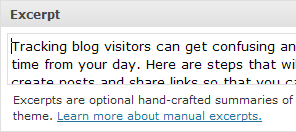Simple Do-It-Yourself SEO
It seems like spam is trending toward Search Engine Optimization (SEO) and “get your website on the first page of Google”. Although they are a nice break from the male enhancement or “buy this stock” spam, they are still annoying to receive. Why not save some money and do a few simple SEO updates yourself? This is particularly easy to do with WordPress.
1. Install an SEO plugin
I like the Light SEO plugin for its ease of manipulating titles, description and keywords. It adds a few fields for customizing these items at the bottom of the post form.

2. Page Title
Now that you are equipped with an SEO editor, you need to know what to do. The most important component of SEO is the page title. This is the text that shows at the top of browser windows above the menu and browser navigation buttons. Make your titles relevant to the page they are on. This is often used as the first part of an individual web search result – the larger, bold text link. Most of the time the header text for your post or page will be great. If you want to include your company name or blog name in the title, place it at the end.


3. First Page Header (Header 1 or H1 tag)
Many people confuse the first page header with the page title. This is commonly referred to the title in writing, but is technically referred to as the first page header (or H1 tag) in web pages. It is an important component of page SEO and is sometimes used in web search results. As I described above, your page title and first page header can usually be the same (less the company or blog name at the end). Make sure this element only occurs once. If you have multiple topics within a page or blog post, use the second header setting (Header 2 or H2) for these sub-titles. Web search engines can get confused in “crawling” your website for content when they come across multiple H1 tags and may mis-label your page in search results or lower its page rank.
4. Content is Key
What you write in your pages or posts is important to improving your inbound links for certain keywords. Create remarkable content with strategic use of keywords and phrases, but don’t over-do it. Search engines are good at sniffing out keyword bloat. Long over are the days of stuffing hundreds of keywords at the bottom of a page in a hidden color. Creating remarkable content is the key to successful blogging. You want people, especially high-profile websites, to link back to your pages or posts. This is one of the largest factors for increasing your page rank.
5. Use Descriptive Links
Placing “click here” links or buttons on a page is bad practice. Creating descriptive links is not only better for the visitor, but search engines place more weight on them as keywords and phrases.
6. Don’t Forget the Image Alternate Text
The image alternate text option was originally (and still is) intended as an aid for people with disabilities. Instead of coming across a generic “image” placeholder, alternate text allowed a description to be tied to it. This is displayed when you mouse-over an image. It also helps SEO by allowing more descriptive text or keywords to be added.

7. Page Description (META Description)
The page description, one of the Light SEO options, is a component that is unseen to the visitor. Many search engines display this element in search results. Create a short one-to-two sentence summary of the page or post for the page description. Some WordPress templates or plugins will do this via the Excerpt option, which is usually located just below the content edit box.

8. Page Keywords (META Keywords)
The page keywords are good to incorporate, but some search engines like Google ignore META keywords because of how easy it is to bloat this hidden text with irrelevant keywords. This is the last element of the Light SEO plugin. Google has a list of recognized META tags in its Google Webmaster Tools support area. Some WordPress templates or plugins allow the post tags to be used as keywords.
Other SEO Items to Consider
There are many other aspects to SEO that should be considered and discussed with your technology consultant. Some of these include:
- Permalinks – These replace cryptic web addresses with descriptive addresses (i.e. yourwebsite.com/index.php?p=1 vs. yourwebsite.com/about/).
- Redirects – Search engines can see your website as two websites if you do not have it setup to redirect www.yourwebsite.com to yourwebsite.com or vice versa. This makes your website compete with itself.
- DMOZ – Submit your website to a relevant category on DMOZ
- SiteMaps – Create a SiteMap and submit it to Google Webmaster Tools. This allows Google to crawl your website better and at better intervals.
- Website Grader – Run your website through Hubspot’s Website Grader. Keep a record of its progress as you improve your website.
- Google Analytics – Add the Google Analytics tracking code to your website. It is helpful for making adjustments to your content, keywords and tracking visitors.
What SEO techniques or tools do you use?
I would like to see what you use for SEO, especially if there are some simple techniques that non-tech users can do.
Comments
2 Comments on Simple Do-It-Yourself SEO
-
Martin von Wyss on
Wed, 7th Mar 2012 9:44 pm
-
Zhmakin01 on
Tue, 10th Nov 2020 4:21 am
Great blog! In the two years that elapsed between when you wrote this and when I finally read it, some things in Light SEO have changed. They have more fields and there’s no reference to the H1 or “First Page” header tags. I look forward to your update! And thanks.
Добрый день!!
Tell me what you're thinking...
and oh, if you want a pic to show with your comment, go get a gravatar!







